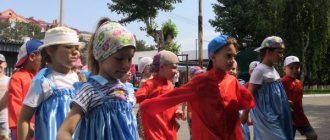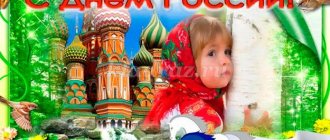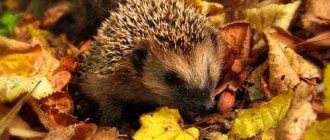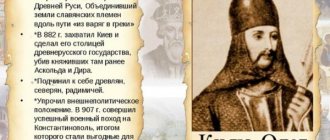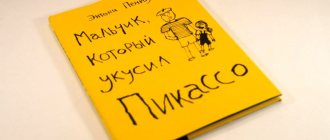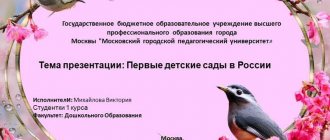Familiarization of preschoolers with the state symbols of Russia
I suggest using the following as sample questions for talking with children:
· What is this? (Coat of arms of Russia, flag of Russia).
· Name the colors of our country's flag. (White blue red).
· What do the colors of the Russian flag mean? (Goodness and beauty; white – snow, clouds, blue – sky, rivers and seas, red – fire).
· What is depicted on the coat of arms of Russia? (Double-headed eagle, horseman defeating the serpent).
· What does the image of a double-headed eagle mean? (Sun).
· What does the image of a horseman mean? (Victory of good over evil).
· Where can you see the image of the coat of arms of Russia? (On coins, documents).
· Why do we need an image of the coat of arms on coins, and an image of the flag on cars and airplanes? (So that they can be distinguished from coins, cars and airplanes of other countries).
· Why does a country need a coat of arms and a flag? (To unite people living in our country, to be a distinctive sign).
Summary of the lesson “State symbols of Russia” in the preparatory group
Yulia Ivanova
Summary of the lesson “State symbols of Russia” in the preparatory group
Topic: “ State symbols of Russia ”
in
the preparatory group .
Goal: to form a basic understanding of the symbolism of our country and its meaning.
— To consolidate and generalize children’s knowledge about the state symbols of Russia - the flag , coat of arms, anthem.
— consolidate children’s knowledge about the main unofficial symbols of the Russian Federation .
— To develop in children a sense of patriotism and love for their Motherland.
— To develop children’s emotional responsiveness to music and folklore.
— To develop a respectful attitude towards the state symbols of Russia , an understanding that they are designed to unite the residents of one country.
Vocabulary work: Russians , planet Earth, globe, symbols , peace-loving people, double-headed eagle, St. George the Victorious.
Preliminary work: creating a corner for moral and patriotic education, learning poems about the Motherland, conversations about friendship.
Material for the lesson : image of the coat of arms of Russia , maps of Russia , the President, Red Square and the Kremlin's Spasskaya Tower, a globe, a tape recorder and a cassette with a recording of the Russian ; audio recordings of calm music; ribbons of blue, white, red colors; accordion, picture of a birch tree, model of a Russian stove, toy bear, matryoshka. Audio recordings: “ditties”
and the round dance game
“Rivek”
Planning work to familiarize children of senior preschool age with the coat of arms and flag of Russia
| Familiarization tasks | Classes | Games, leisure | Excursions, walks, targeted visits |
| 1. Introduce the history and symbols of the state emblem and flag of Russia. 2. Form ideas about the types of flags (state, naval, Victory Banner, presidential standard) and coats of arms (state, coat of arms of Moscow, hometown, region) and their purpose. H. Repeat and generalize the knowledge acquired by children. | "Double-headed eagle and horseman" A research lesson to familiarize yourself with the outside world, in which children will learn why a coat of arms is needed. "White blue red" A lesson where children get acquainted with the history of the Russian flag. | Quiz competition “Coat of Arms and Flag”. During the quiz competition, children's ideas about the origin and functional purpose of the coat of arms and flag are summarized. It is also necessary for preschoolers to repeat and learn the symbolic meaning of the colors of the coat of arms and flag of Russia, the images included in the state emblem of our country. The story of the Victory Banner It is advisable to include it in leisure time or a holiday dedicated to Victory Day. You can devote a separate lesson to the Victory Banner. | Excursion to the local history museum (city, district, school). During the excursion, children should pay attention to various types of coats of arms and emblems, ancient and historical banners, state and military flags. You can also organize a visit to the Museum of Military Glory, a military unit. |
Getting to know the symbols of Russia! (Conversation)
Objectives: • To introduce the main symbols (anthem, flag, coat of arms). • Expand children's understanding of the state symbols of the Russian state and their historical origin. Objectives: •Summarize children’s knowledge about the National Flag. Introduce the meaning of the colors depicted on the flag. •To instill in children a sense of pride, admiration for the beauty of the nature of Russia, the State Flag.. •To instill in children respect for the power of the Russian state, love for the Motherland, a sense of pride for their country
Progress of the conversation
We live in a large, kind, strong and very beautiful country called Russia. Our forests and fields stretch from the southern seas to the polar region. You are the only one in the world! You are the only one - God-protected native land! These are the words from the National Anthem of the Russian Federation. But the country is not just fields and forests, cities and villages. This is a state. And each state has its own conventional signs - symbols that distinguish it from others. Symbols are objects, images or words that have special meaning for us. State symbols are symbols that have special meaning for citizens of a particular state. Usually, while life goes on as usual, citizens do not very often remember state symbols - they do not walk along the streets with state flags every day, do not admire their state emblem for hours and, when gathering together, sing not the national anthem, but other songs. But if suddenly some serious danger appears that threatens everyone, for example, cruel enemies come or, conversely, general joy happens, for example, the country’s national team becomes the world champion, then it turns out that state symbols are the very thing which helps citizens feel their community, unity, and unite into one whole. Citizens take to the streets with national flags, look with pride at the coat of arms of their country and even, standing shoulder to shoulder, can sing the national anthem with tears in their eyes. Our country, like any self-respecting state, has its own state symbols. These are the National Flag, the National Emblem and the National Anthem. Flag It is known that the flag was created to flutter. Therefore, usually flags are raised high up on flagpoles and masts - where there is more wind and where the flag can fly beautifully - so that everyone can see it and be proud of their country. The flag is one of the important symbols of the state. The State Flag of Russia is a symbol of unity and harmony, national identity and culture. And if you approach a government building, you will certainly see the Russian flag flying over it. The flag is a sign of respect for the Motherland. Desecration of the flag is subject to severe punishment, as an insult to the state. – Tell me, guys, what does the Russian flag look like? (Children's answers.) - That's right, this is a rectangular panel consisting of three stripes of three colors: the top is white, the middle is blue and the bottom is red. – Does anyone know what these colors mean? (Children's answers). Each color of the Russian flag has its own meaning.
Coat of Arms of Russia The State Emblem is necessarily depicted on all important state papers, letting everyone who sees these papers understand that they are important and state-owned. For example, the state emblem adorns all decrees of the President of Russia. The state emblem also adorns the passports of Russian citizens and other documents issued by the Russian state.
The coat of arms with a golden double-headed eagle on a red field is reminiscent of the coats of arms of the late 15th-17th centuries. The eagle design is similar to those designs that decorated the monuments of the era of Peter the Great. Above the heads of the eagle are three historical crowns of Peter the Great, symbolizing in the new conditions the sovereignty of both the entire Russian Federation and its parts. The scepter and orb represent state power and a unified state. The image of a horseman slaying a dragon with a spear is one of the ancient symbols of the struggle between good and evil, light and darkness, and the defense of the Fatherland. The restoration of the double-headed eagle as the State Emblem of Russia symbolizes the continuity of Russian history. The coat of arms of modern Russia is new, but its components are made in the traditions of the history of our state. Let's repeat once again what the elements of the coat of arms mean. Anthem The national anthem is a solemn song of praise dedicated to the Motherland. The anthem is exactly the same symbol of the state as the coat of arms or flag, but unlike the coat of arms and flag, the anthem can not only be seen, you can also hear or sing it yourself. There is a special Federal Constitutional Law “On the State Anthem of the Russian Federation”. This law explains where and when the national anthem is played and how people should behave. For example, the law says that you cannot sit or lie down during the official performance of the Russian anthem. You must listen or sing the national anthem while standing. Moreover, boys must remove their hats during the singing of the anthem, while girls can remain in hats or scarves. - Guys. Do you want to hear the anthem of our state? You and I love and are proud of our country, which means we should be proud of its symbols. Let's express our respect for the Russian anthem and listen to it properly, standing. Listening to the Russian anthem. Guys, who rules our country? (children’s answers) President The President of Russia is the head of state. He is the most important person in our country. The President has power. But the President is not a leader, not an emperor, not a ruler or a ruler. We should not fall on our knees before our President and swear allegiance to him. On the contrary, it is not we, the citizens, who serve the President, but the President has sworn to faithfully serve us, the people of Russia. Being President is a job. Today, Vladimir Vladimirovich Putin is the President of the Russian Federation. Citizens of Russia are proud of the State Emblem, flag and anthem and the President.
Progress of the lesson.
- Guys, I have an envelope in my hands that is addressed to you. Let's open it and see what's in it.
- This letter. Let's read it. (Dear guys. We are children from Finland.
We really want to know about your country, about its state symbols . We really want you to help us).
- Well, guys, what can we tell you about our country?
-I suggest you send a video of our lesson to Finland , children from Finland will watch everything and learn a lot about our country.
- So, let's start
— Our country is called Russia , and all the people living in our country are called... ( Russians )
.
— What is the name of the main city of our country, the capital? (Moscow)
.
— What do they call the main person of our country? (The president)
.
— What is his first and last name? (V.V. Putin)
.
— Each state has its own distinctive signs or symbols . Which ones do you think? (Coat of arms, flag and anthem)
.
Russia also has them . These are the flag, coat of arms and anthem.
1. Conversation on issues about the flag.
— What parts does the flag consist of? (Out of 3 equal stripes)
.
— What color is each stripe? (Top – white, middle – blue, bottom – red)
.
-White color means peace and purity
— Blue color means loyalty and truth
— Red color means courage and bravery.
— Where can you see the Russian ? (on buildings, on holidays, on documents)
.
— You can tell by the colors of the flag what kind of people live in our country. (Peaceful, faithful, truthful, courageous and brave)
.
What more can we say about our flag?
Well done guys, you answered well. Now I suggest you relax a little, take ribbons of any color and move with them to the music. (calm music sounds)
2. Conversation on questions about the coat of arms.
— And now let’s take a closer look at the next symbol - the coat of arms of Russia .
— Who is depicted on our coat of arms? The wings of an eagle look like the rays of the sun. The eagle has two heads, one looks to the west and the other to the east of our country. The eagle has a scepter in its right paw and an orb in its left. These are symbols of power .
(Showing an image of the scepter and orb)
.
— A scepter is a short stick decorated with gold and precious stones. He shows"
what needs to be done to make
the state strong and rich. The power is a golden ball with a cross on top. The one who governs the state must protect it.
— What is located on the eagle’s chest? (Shield)
.
— Who is depicted on the shield? (Rider on a horse)
.
- What is the name of the rider? (St. George the Victorious)
.
-What is he holding in his right hand? (Silver Spear)
.
“He kills the dragon with this spear.” The dragon is a symbol of evil .
The image of a horseman killing a dragon signifies the victory of good over evil. Where can you see the coat of arms of Russia ? (On the flag, on documents, on money)
.
3. Conversation on questions about the anthem.
— The third symbol of our state is the anthem . This is the main song of our country. Have you ever heard it? (Yes or no)
.
— When the anthem sounds, all citizens stand up. Listen to him.
— Guys, where can I hear the anthem? (At holidays, on TV)
.
Now let's listen to our anthem. (children stand up)
- Well done, sit down on the chairs. We talked about the state symbols of our country . And there are also folk ones. Take any symbol on the tables and come to me . Tell us about your symbol while listening to music (children approach the table on which there is an accordion, a matryoshka doll, a model of a Russian stove, a toy bear, a picture of a birch tree. Children perform ditties learned during a music lesson to an audio recording)
-You guys talked about many folk symbols , but what would Russia be without games and round dances ? I suggest you play the Russian folk game "Rucheek"
.
And to make our trickle bigger, take any of our guests by the hand and lead them into a round dance (the audio recording “Trickle”
).
- Well done, sit down on the chairs. We talked a lot today about our country. What is Russia for each of you (children’s answers)
.
Summary of the lesson “Symbols of Russia and sights of Moscow” Purpose: 1. To consolidate children’s knowledge about the symbols of Russia, about Moscow and its sights. 2. Arouse interest in the present, past and future.
Summary of integrated educational activities with children of the preparatory school group “State Symbols” Purpose: to acquaint children with the history of the country, with the state symbols of Russia (flag, coat of arms, anthem); Objectives: develop cognitive skills.
Summary of the complex lesson “State symbols of Russia. Let’s create an emblem for our group” in the senior group Goal: Formation of basic ideas about the symbols of our country and its meaning. Development of cognitive interest in the history of the state.
Summary of an open lesson in the senior group “Symbols of Russia” Summary of an open lesson in the senior group on the topic: “Symbols of Russia” Prepared by teacher: Kalnitskaya V. A. Purpose of the lesson: Education.
Workshop for pupils of the social rehabilitation center for minors “State symbols of Russia” State symbols of Russia Goal: To form a respectful attitude towards the symbols of our state; learn the Russian anthem; Progress of the lesson: (c.
Lesson summary “State symbols of Russia” Topic: “State symbols of Russia” Goal: expanding children’s knowledge about the state symbols of Russia (coat of arms, flag, familiarity with the anthem.
Source
